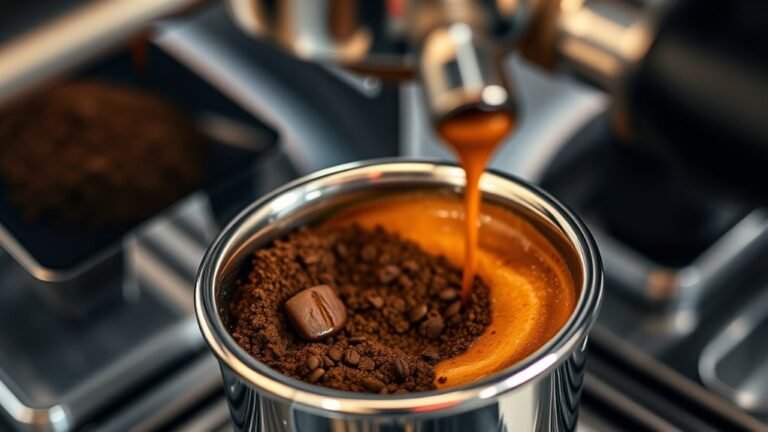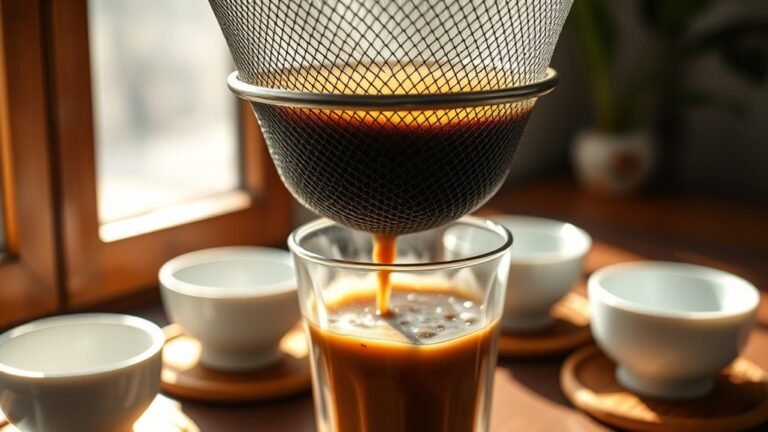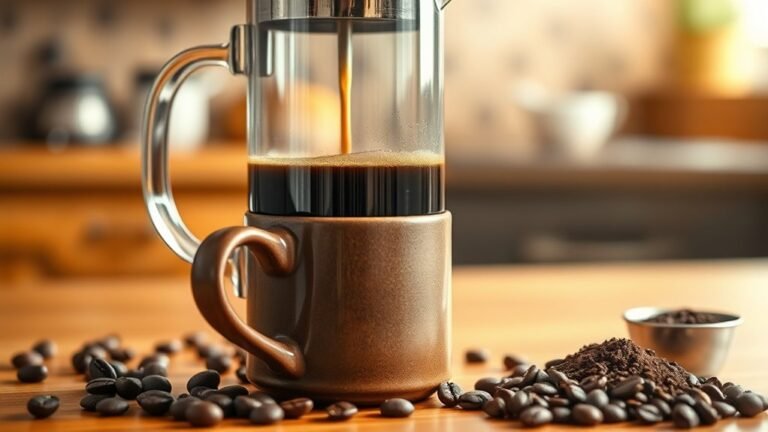How to Dial in Your Espresso Machine for the Perfect Shot
To dial in your espresso machine, start by selecting fresh, quality coffee beans suited to your taste. Weigh your coffee dose precisely with a calibrated scale, then adjust the grind size to control extraction time—finer for slower, coarser for faster shots. Tamp evenly with consistent pressure (about 30 pounds), keeping the puck level. Aim for a balanced extraction lasting around 25–30 seconds, adjusting variables based on taste and timing. Master these fundamentals, and you’ll gain refined control with each shot.
Understanding Your Espresso Machine Components
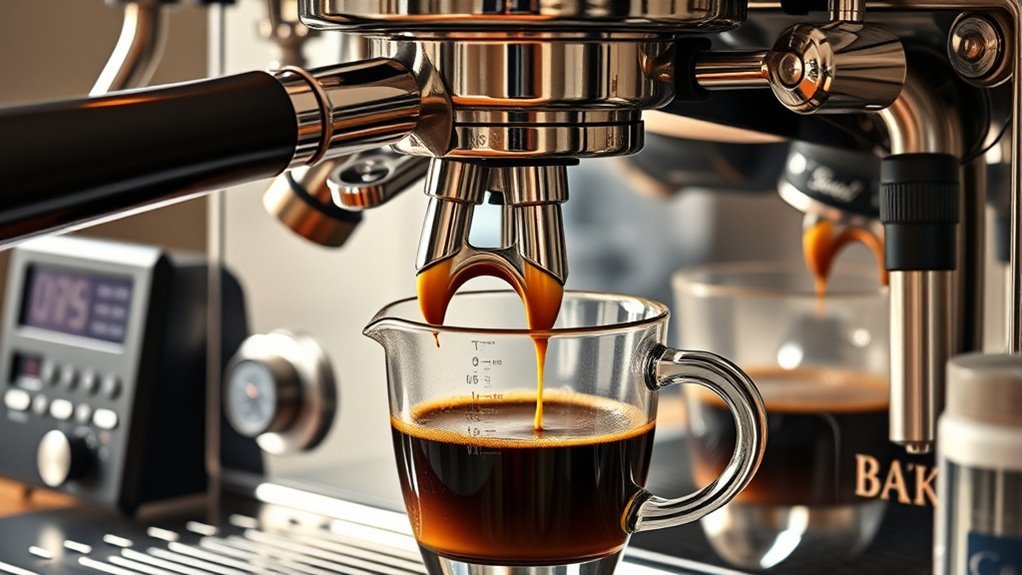
Before you can effectively dial in your espresso machine, you need a clear understanding of its key components and how they interact. The main espresso machine parts include the portafilter, group head, boiler, and pump. The portafilter holds the coffee grounds, while the group head directs hot water through the grounds. The boiler heats water to the precise temperature, essential for consistent extraction. The pump generates the brewing pressure, typically around 9 bars, which forces water through the coffee puck evenly. If your brewing pressure fluctuates, the shot quality will suffer, leading to under- or over-extraction. Knowing how these parts work together lets you troubleshoot and adjust settings confidently. Mastering this technical foundation gives you the freedom to control every aspect of your espresso’s flavor and texture.
Choosing the Right Coffee Beans
When dialing in your espresso machine, selecting the right coffee beans plays a critical role in achieving ideal extraction. You’ll want to prioritize bean freshness, as stale beans compromise flavor and crema quality. Coffee origin influences acidity, body, and sweetness; understanding these nuances lets you tailor your shot to freedom in taste. Here’s a quick reference:
| Coffee Origin | Flavor Notes | Ideal Use |
|---|---|---|
| Ethiopia | Floral, Citrus | Bright, Light |
| Colombia | Balanced, Nutty | Versatile, Smooth |
| Brazil | Chocolate, Nutty | Bold, Full-bodied |
Adjusting Grind Size for Optimal Extraction
You’ll need to fine-tune your grind size to control extraction time and flavor balance accurately. A finer grind increases resistance, slowing extraction, while a coarser grind speeds it up, so consistency is essential for repeatable results. Adjust your grind based on shot timing to achieve ideal extraction without over- or under-extraction.
Importance of Grind Consistency
Although dialing in your espresso machine involves multiple factors, grind consistency plays a critical role in achieving ideal extraction. When you maintain high grind uniformity, water flows evenly through the coffee puck, preventing channeling and under-extraction. Variations in grind size create uneven resistance, causing some grounds to over-extract while others remain under-extracted. This imbalance diminishes flavor clarity and body. You’ll notice that even slight deviations in particle size can greatly impact shot quality, so investing in a burr grinder that produces consistent particle distribution is essential. By prioritizing grind consistency, you gain precise control over extraction parameters, enabling you to refine your espresso’s balance, sweetness, and crema. Ultimately, achieving consistent grind size frees you to tailor every shot to your exact taste preferences.
Effects of Finer vs. Coarser
Mastering grind consistency sets the stage for adjusting your grind size to optimize extraction. When you dial in a finer grind, the increased surface area enhances solubility, allowing water to extract coffee compounds more efficiently—this is where finer grind benefits become evident: richer flavor, fuller body, and balanced acidity. However, if you go too fine, you risk over-extraction and channeling, which can result in bitterness. On the other hand, a coarser grind reduces resistance, speeding up water flow, but coarser grind drawbacks include under-extraction, weak flavor, and sour notes due to insufficient contact time. Your freedom lies in finding the exact grind size that balances extraction without sacrificing flow rate or flavor complexity, tailoring each shot to your taste preferences and espresso machine’s capabilities.
Adjusting Based on Extraction Time
How long should your espresso shot take to extract? Typically, aim for 25 to 30 seconds, but this depends on your specific extraction variables. If your shot timing is too fast, your grind is likely too coarse, causing under-extraction and a weak flavor. Conversely, if it’s too slow, the grind may be too fine, leading to over-extraction and bitterness. Adjust your grind size incrementally to find the sweet spot where shot timing aligns with desired flavor profiles. Remember, shot timing isn’t just about duration—it’s about balancing pressure, dose, and grind to optimize extraction. By dialing in these variables precisely, you gain freedom to craft espresso that reflects your personal taste preferences with consistency and control.
Measuring the Perfect Coffee Dose
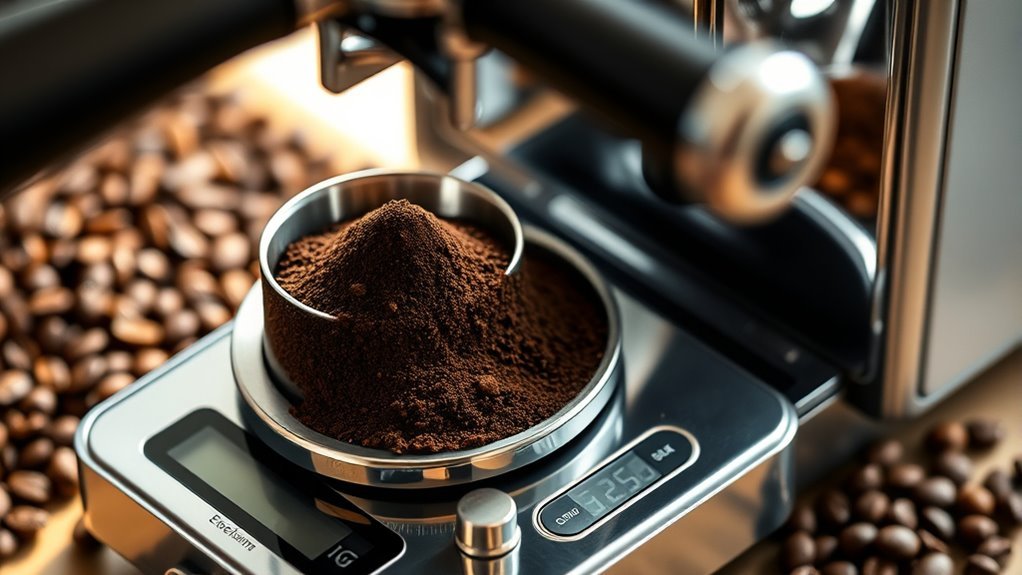
You need to measure your coffee dose with precision to guarantee consistent extraction and flavor. Using calibrated tools like digital scales or dosing funnels helps maintain accuracy within 0.1 grams. Mastering this step lets you replicate the ideal shot every time.
Accurate Coffee Measurement
Consistency in dosing is critical for extracting balanced espresso shots, and that starts with measuring your coffee accurately. Using precise coffee scales is the foundation of reliable measurement techniques. You want to eliminate guesswork and guarantee each dose is identical, so your espresso machine delivers consistent pressure and extraction.
To master accurate coffee measurement, focus on:
- Weighing your coffee grounds before grinding
- Calibrating your coffee scales regularly
- Using a zeroing function to exclude the portafilter weight
- Measuring doses within ±0.1 grams for precision
- Recording weights to refine your technique over time
Tools for Dosing
Although accurate measurement hinges on precision scales, selecting the right dosing tools can streamline your workflow and enhance repeatability. Using proper dosing techniques guarantees consistent coffee weight, which directly impacts extraction quality. Coffee scales with built-in timers allow you to monitor dose and extraction simultaneously, merging precision with efficiency. Tools like dosing funnels, calibrated scoops, and levelers help you control coffee distribution within the portafilter, reducing channeling risks.
| Tool | Purpose | Benefit |
|---|---|---|
| Coffee Scale | Measures dose precisely | Guarantees repeatable dosing |
| Dosing Funnel | Guides grounds into filter | Minimizes mess and waste |
| Leveler | Evens coffee bed surface | Promotes uniform extraction |
Master these tools, and your espresso shots will consistently hit the mark.
Tamping Techniques to Ensure Even Extraction
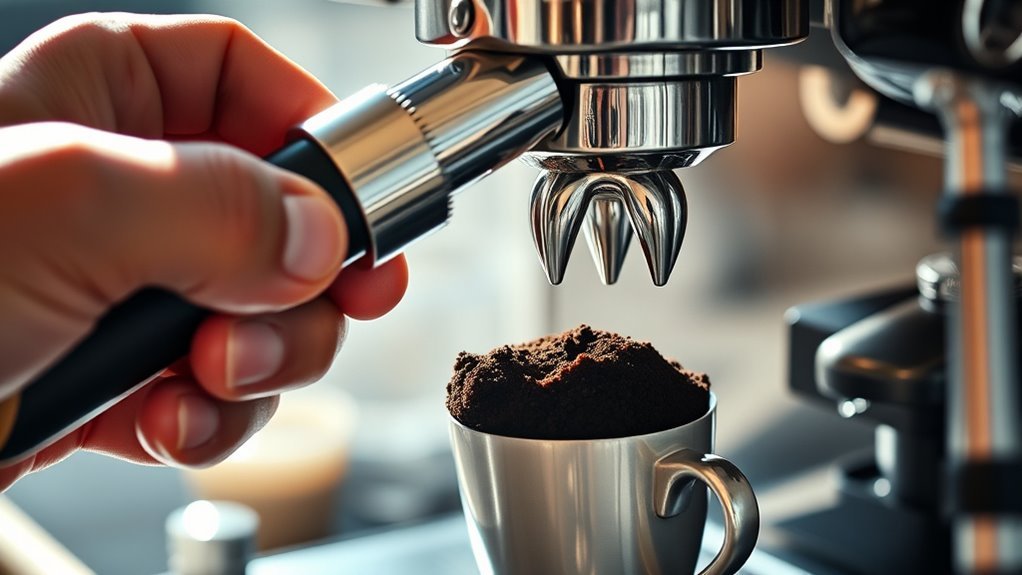
Mastering tamping techniques is essential for achieving even extraction, as uneven pressure can cause channeling and under-extraction. When you apply consistent tamping pressure, you create a uniform coffee bed that water flows through evenly, revealing balanced flavor profiles. Focus on refining your tamping technique by controlling both angle and force to avoid uneven puck density.
Consistent tamping pressure ensures uniform extraction and balanced espresso flavors by preventing channeling and uneven puck density.
Key points to guarantee precision include:
- Apply 30 pounds of tamping pressure steadily
- Keep the tamper level and centered on the basket
- Use a consistent, smooth tamping motion without twisting
- Inspect the puck surface for cracks or unevenness
- Practice regularly to develop muscle memory and control
This disciplined approach grants you freedom in dialing in your espresso for flawless shots every time.
Timing Your Shot for Balanced Flavor
Once you’ve secured an even puck with proper tamping, the next factor to control is shot timing, which directly influences extraction quality. Shot duration typically ranges between 25 to 30 seconds, but dialing in this timing depends on your coffee’s grind size, dose, and pressure. You want to aim for a shot duration that achieves ideal flavor balance—extracting enough soluble compounds without drawing out excessive bitterness or sourness. Begin by timing your shot as you pull it, then adjust grind size to speed up or slow down extraction. If your shot runs too fast, flavors will be underdeveloped; too slow, and bitterness dominates. Through precise timing and adjustments, you gain freedom to craft espresso shots that highlight your beans’ nuanced profiles.
Troubleshooting Common Espresso Issues
Espresso brewing can present several common issues that affect flavor, texture, and consistency. To troubleshoot effectively, focus on these critical factors:
- Espresso temperature: Too high or low disrupts extraction, causing bitterness or sourness.
- Water quality: Hard or impure water alters taste and can damage machine components.
- Grind size: Inconsistent grind leads to channeling or under-extraction.
- Dose and tamp pressure: Uneven tamping or wrong dose affects flow rate and shot balance.
- Shot timing: Deviations from ideal time skew flavor profiles.
Frequently Asked Questions
Can Water Temperature Affect My Espresso Shot Quality?
Yes, water temperature critically impacts your espresso extraction. If it’s too hot, you risk over-extracting, resulting in bitter flavors; too cold, and under-extraction leaves your shot sour and weak. You want to maintain a stable temperature between 195°F and 205°F to balance solubles extraction. Controlling water temperature lets you reveal nuanced flavor profiles, giving you the freedom to craft espresso shots tailored perfectly to your taste preferences.
How Often Should I Clean My Espresso Machine?
Think of your espresso machine like a finely tuned engine that needs regular care. Sticking to a strict cleaning schedule—daily backflushing, weekly deep cleaning, and monthly descaling—is vital for peak performance. Maintenance tips include wiping group heads and steam wands after each use to prevent buildup. By following these steps, you guarantee your machine operates smoothly, giving you the freedom to enjoy consistent, high-quality espresso without unexpected breakdowns.
What Is the Best Milk Frothing Technique for Espresso-Based Drinks?
For the best milk frothing technique, you’ll want to focus on creating a smooth microfoam texture. Start with cold milk and position the steam wand just below the surface, allowing air to incorporate gradually. Once the milk reaches about 140°F, submerge the wand deeper to heat evenly. This precise method helps you achieve velvety microfoam perfect for latte art, giving you the freedom to craft beautiful, professional espresso-based drinks every time.
Can Altitude Impact Espresso Extraction and Taste?
Yes, altitude effects can markedly impact your espresso extraction and taste. At higher elevations, lower atmospheric pressure changes water boiling points, affecting extraction variables like temperature and pressure stability. You’ll need to adjust grind size, dose, and extraction time to compensate. Experimenting with these variables lets you maintain balanced flavor despite altitude challenges, giving you the freedom to craft a perfect shot no matter where you’re brewing.
How Do I Store Coffee Beans to Maintain Freshness?
To keep your coffee beans fresh, you’ll want to store them in airtight containers to prevent exposure to oxygen, which deteriorates flavor. Vacuum sealing is ideal—it removes air and locks in freshness, extending the beans’ shelf life. Avoid heat, light, and moisture by placing your container in a cool, dark spot. By controlling these factors, you preserve the beans’ oils and aromas, ensuring every cup tastes as vibrant as the day you bought them.

